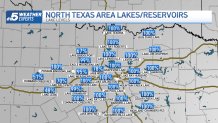With all the rain it may feel like May was one of the wettest in recent history, but a look at historical data from the National Weather Service shows that last month didn't even crack into the top 10.
NWS data showed rain was recorded on 21 days last month, but on seven of those days, we only recorded a trace of precipitation. Two of the wettest days, though, came in toward the end of the month with 1.91 inches on May 28 and 1.28 inches on May 30.
So how much rain did we get? As of Friday afternoon on the last day of the month, 7.8 inches of rain had been recorded at Dallas-Fort Worth International Airport for May. While the total rainfall for May isn't a record or even in the top 10, it is well above the normal 4.63 inches typically received.
The wettest May on record occurred just nine years ago in 2015 when 16.96 inches of rain was recorded at the airport. The NWS said at the time that the volume of precipitation received in May 2015 was the equivalent of 35 trillion gallons of rain.
Get top local stories in DFW delivered to you every morning. Sign up for NBC DFW's News Headlines newsletter.
The rainfall total from this May was still about two inches shy of breaking into the top 10, where more than 9.48 inches of rain would have been needed to beat a record set in May 1936.
While May is typically the wettest month of the year in North Texas, the observation from 2015 is the only month of May this century to crack into the top 10.
All this talk about the wettest months on record may make you wonder about the wettest month of any month, well that record goes back to April 1922 when 17.64 inches of rain was recorded in North Texas.
METEOROLOGICAL SPRING ENDS MAY 31
The nearly eight inches of rain received in May helped the overall spring totals. For meteorological spring, which runs from March 1 through May 31, this was the eighth wettest spring on record with 19.93 inches of rain received.
This month's rainfall also helped make this year the seventh wettest year to date with 25.07 inches of rain from Jan. 1 through May 31.
MANY AREA LAKES ARE AT CONSERVATION LEVELS
With this spring's rainfall, many of the area's lakes and reservoirs are now full at conservation levels. That doesn't mean the lakes can't hold any additional water. Above the reservoir's conservation pool is a flood pool where floodwater can be stored during times of heavy rainfall. If needed, dams at lakes and reservoirs can be opened to allow water to flow downstream through channels into other reservoirs.

DROUGHT DRIES UP AFTER VERY WET SPRING
Here's a look at the latest drought monitor, released May 30, 2024. There is currently no drought in North Texas.





